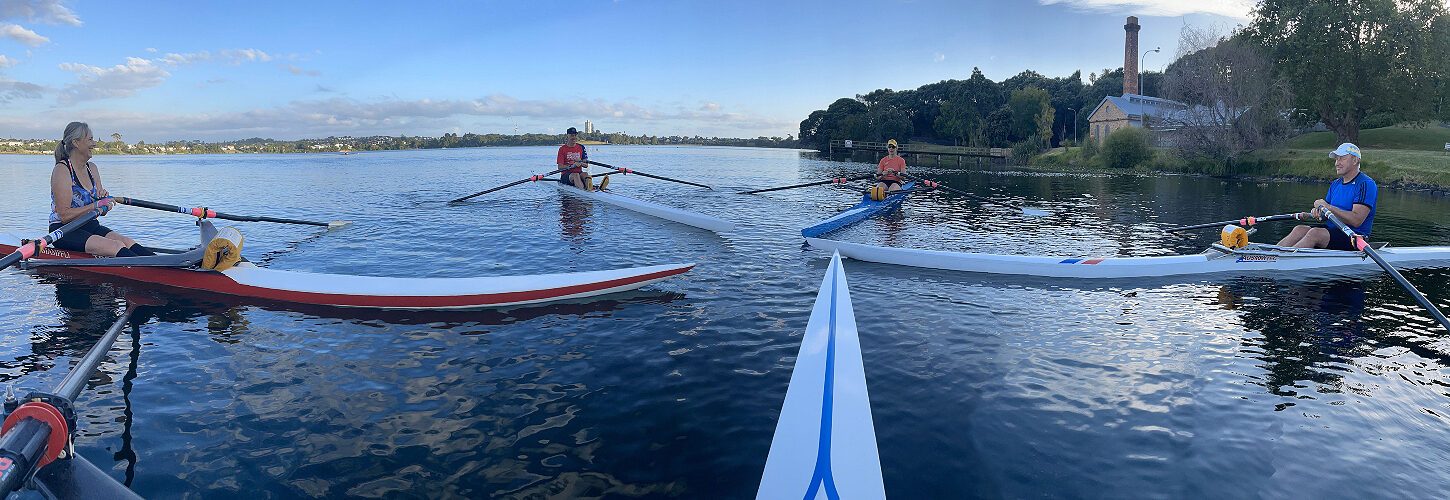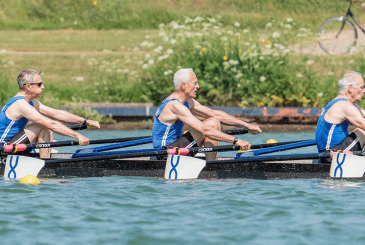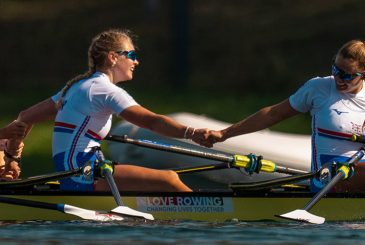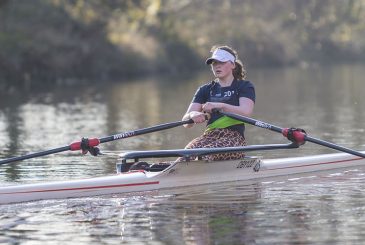How can you improve your rowing? Rebecca Caroe, who runs Faster Masters Rowing, training and education programmes, shares her top tips in our latest article in the masters series
Much of the satisfaction gained from rowing comes from measuring progress – whether you are a recreational athlete or a top-level master competing internationally – we humans like to track our direction of travel.
There are two types of goal – process goals and measured achievement goals.
1 – Process goals include both objective and subjective aspects. These could be keeping my blades longer in the water or making specific technique improvements. Mental training can also include goals such as not allowing yourself to quit during an erg, or arriving at the boathouse before the outing time so you can do a dynamic warm up.
2 – Objective goals are measurable such as a timed distance workout. Olympic gold medallist Brad Alan Lewis wrote a book, Lido for Time, as he tracked his time rowing around Lido Isle in Newport Beach, California. Other objectives include accountability, like a chart of the number of times you train each week.
“No goal is worth having if you cannot track progress towards it”
If you race, you will want to plan your rowing season – this involves choosing one big winter and one big summer race event. Typically, these will be a head race in winter and side-by-side racing in summer. These goals require a “peak” performance for the race and your training programme will need to reflect the race date and include a progressive training taper for 10-14 days beforehand. If you want to learn more about writing peaking programmes, the book Consistent Winning is a core text.
Jared Day is a racing master at Buffalo Rowing Club, Eastern Cape, South Africa who takes his short, medium and long-term performance goals and factors them into his training regime and meal plan. He is training for the World Rowing Coastal Championships in Saundersfoot, Wales, this year.
As a recreational rower your goals probably won’t necessitate adjusting your training programme to the same extent. But they do require focus and measurement. No goal is worth having if you cannot track progress towards it.

Elizabeth Burt of Riverfront Rowing in Hartford Connecticut, USA, agrees: “Since the pandemic, I’ve only sculled, and came to the realisation that what I love is just to do long rows on the Connecticut river and not worry about metres or stroke rate. I push myself to get a good workout, but I stopped keeping track of the metrics.”
Personal goals could include improved fitness, weight loss or acquiring bladework skills. For these you also need to understand what will help you move towards your goal. Will you need longer or more intensive training to get fitter, or gym work using weights to counter osteoporosis?
“We do five sprint races over 500m and the cake afterwards is compulsory!”
Bladework skill is acquired through drills and exercises and then testing yourself as you increase stroke rates and pressures – so choose good drills and get yourself videoed doing a few strokes so you can see what you are doing.
Whatever goals you choose, write them down and put a diary note to re-test or reassess your progress every six weeks through the year.
Trafford Rowing Club’s Susie Loates is Vice Captain for their Recreational Squad. This group is made up of everyone who doesn’t want to race or can’t commit to the racing squads’ training plans and formal racing. Yet they still race in the North West of England Explorer Series where crews visit different clubs in the region and race each other with the host club providing boats.

Susie explains: “The event series is aimed at post-learn to row crews, adaptive crews and those who don’t want to race.”
“Our goals are to explore more of the Bridgewater Canal and race the Explorer Series in stable coxed quads. These races involve crews of five to eight people. We do five sprint races over approximately 500m on the day and the cake afterwards is compulsory!”
Tony Tikiku of Porirua Rowing Club, New Zealand, uses a Garmin watch when he trains on the water and the asensei app and the Concept2 monitor for his land-based rowing machine workouts.
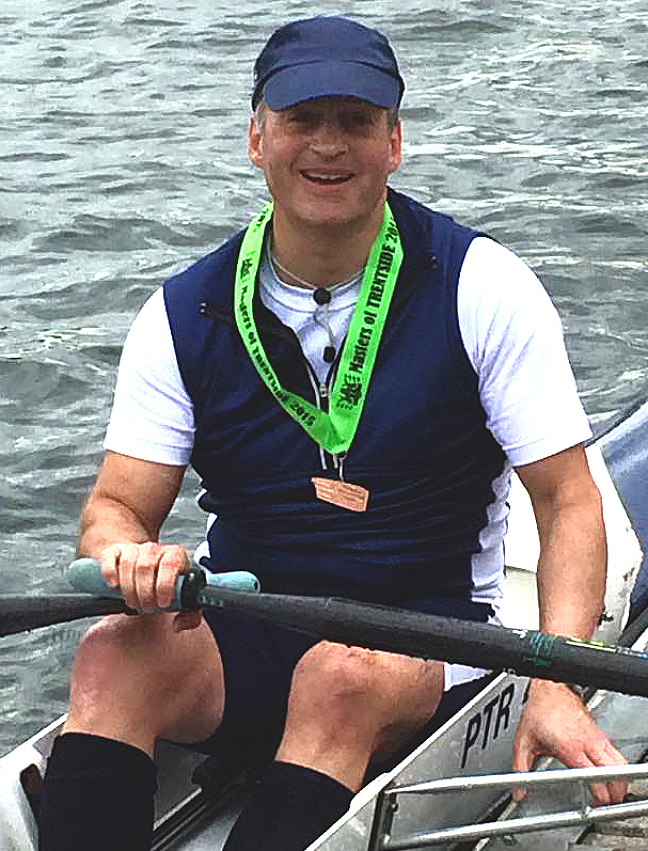
By contrast, James Holmes-Siedle of Putney Town Rowing Club uses data goals on the water for the masters women squad he coaches at Putney Town Rowing Club. One session he likes is to set a 500-metre split from a 250-metre piece and then get the crew to achieve the same split for 500 metres, 750 metres and 1 km during the same outing. He confesses that his squad laughs at the amount of data he collects and explains: “If I make a rigging change or technique change – data is the only way to really know if it was worth it.”
Since masters are training over the very long term (I like to describe myself as a “lifer”) there will be times when we do less or more rowing. It’s important to come back into training slowly – be gentle on your body. Because even a week off for a holiday means masters cannot just get back in the boat and do the same distance or time on the water as they could beforehand. As a result, goals need to be recalibrated and expectations managed which can be easier said than done.
And join the discussion – tell us what your goals are and how you track your personal progress.
Resources and rowing measurement suggestions
Measuring training can be done in many different ways. Here are some ideas:
- An app or speed coach will track boat speed, distance and rate. Download your data and use Rowsandall.com to analyse your workouts.
- Distance moved per stroke or metres per stroke at rate 18 is a good measure of your base steady paddling speed.
- A 20-minute erg test will measure your fitness progress and re-testing can be done monthly. This test also allows you to set your training performance categories for training. These tests are explained in The Faster 5 Fitness Assessment on FasterMastersRowing.com.
- Heart rate is not a good measure of training intensity, but it has its uses. Read more as I discussed in my podcast here.
- Row set distances regularly as time trials at fixed stroke rates. Record your time and the weather conditions.
- Row set times and record the distance covered (the inverse of the above).
For non-racing masters:
- Do a time-trial over a local course distance just to see how fast you go.
- How many strokes can you row with blades off the water?
- Endurance – what distance can you row before you need rest?
- Try to row with fewer breaks for a drink or chatter.
- Try coxing – can you steer the best possible course through a bridge or along the riverbank without over-steering?
- Learn to scull if you normally sweep. These are all ways to expand your skills and increase your enjoyment!
Get in touch!
We’d love to hear from masters rowers around the country so please get in touch to tell us about your rowing journey, or simply send in some photos of your crew!
Please also let us know if there’s anything you’d like to read about – and we’ll do our best to cover it over the next few weeks.
Send your ideas, experiences and / or photos to [email protected]
Main photo: The author’s coaching group from North Shore Rowing Club on Lake Pupuke, Auckland, New Zealand
–
–
–
–
–
–


